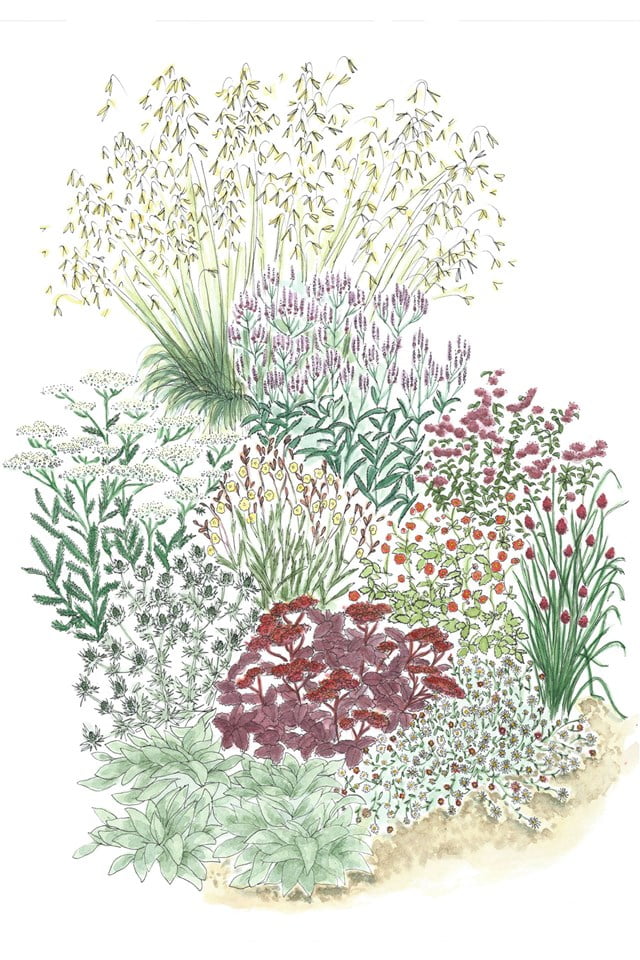Continuing her series on planting plans, Clare Foster calls on the expertise of Cleve West, who has designed a textured border for a gravel courtyard, with drought-tolerant plants that require minimal care.
Cleve West is exhibiting again at this year’s RHS Chelsea Flower Show, where he has designed the M&G Garden. Inspired by the rugged landscape of Exmoor, where he grew up, the garden is a contemporary interpretation of a memory, with a beautiful tapestry of shade-loving shrubs and perennials – very different from the planting design he has produced for us here, for a sunny gravel garden. Although at opposite ends of the spectrum in terms of growing conditions, both schemes come from the same starting point – combining plants in a way that mimics nature.

‘Taking the lead from nature is harder than you think,’ says Cleve. ‘Humans are programmed to impose order on things, so trying to make something look artificially naturalistic or random is surprisingly difficult. One of my tricks is to use the patterns that you see everywhere in nature and recreate them in my planting.’
He cites as an example the Chelsea garden he designed in 2011. ‘It’s difficult to find any sense of place or belonging at Chelsea; the gardens don’t really relate to anything. So I took a photograph of the bark of the plane tree at the back of the garden and overlaid the pattern of the bark with tracing paper onto a plan of the garden; I could then follow the shapes and tones of the bark with the drifts and colours of my planting. I don’t do this for every planting plan by any means, but it gives you a focus and gets your eye in. I try to hold in my mind a snapshot of nature that will be my lead.’
Cleve’s planting plan here is designed for a gravel courtyard measuring roughly 10 square metres, with the space divided into four triangular planting areas by a gravel path. In the centre he envisaged a large copper urn, with an access point in each corner (marked as squares on the plan overleaf). Within the formal layout, the planting is undulating and asymmetrical, designed to spill out over the paths and seed around to soften the geometry of the plan. ‘Geometry and asymmetry work well together, conveying something with order, yet with a little bit ofits own attitude,’ saysCleve. Repeating the same repertoire of plants in each of the four sections was key, but in a random formation to mimic nature.‘Repetition ofcolour and form is very powerful; it makes the scheme more dynamic, as well as harmonising everything. And you’re tuned in to that sort of thing in nature, so it is always pleasing to the eye.
‘My planting schemes are usually more about foliage and texture than flowers, which gives them longevity,’ he continues. ‘I don’t understand how people become obsessed with creating borders that flower constantly through the year. There’s beauty in everything, whether flower, foliage, seed heads or emerging shoots. You just have to look – and if you don’t have the down times, you don’t appreciate the ups. We should embrace the seasons.’
The plants chosen for this plan are all drought-tolerant and tough, needing very little looking after. Weed membrane can be put down under the paths to prevent pernicious weeds encroaching, and the only other task that should be done on a regular basis is to weed out unwanted seedlings. ‘The eryngium, evening primrose and erigeron all seed around. You often get happy accidents with combin-ations you might not have imagined, which is great, but you do have to be quite strict, otherwise something can start taking over. Self-seeders are perfect for the gravelly conditions and I like the fact that nature can have a say in the matter.’

CLEVE’S BORDER PLANT LIST
1. Eryngium giganteum
‘This is a self-seeder and easy to grow, so much so that you have to make sure it doesn’t take over. Its texture stands out against the softer plants,’ Cleve says.
2. Achillea ‘Mondpagode’
‘I love this for its vertical, flat accents. It has creamy yellow flowers that morph to a bone-white colour.’
3. Allium sphaerocephalon
‘This small drumstick allium looks good dotted around in small quantities. Its colour forms a link with the agastache and the sedum.’
4. Oenothera stricta ‘Sulphurea’
‘This evening primrose is a lovely self-seeder – a paler, more subtle yellow than the common evening primrose, with more finesse.’
5. Verbena hastata ‘Rosea’
‘This is one of the tall plants of the scheme and more unusual than the common V. bonariensis, with multi-branching spires of violet flowers, like candelabra.’
6. Stipa gigantea
‘Everyone knows and loves this. It provides the height, but is transparent, so not overpowering.’
7. Stachys byzantina ‘Silver Carpet’
‘This can be a bit of a thug, but it is worth it for its colour and texture. It also attracts the wool carder bee. You can grow things through it – the allium, perhaps or, earlier in the season, tulips.’
8. Potentilla atrosanguinea
‘This is another accent plant, with strong crimson flowers to give the scheme a splash of colour. I’m always keen to have a touch of red somewhere.’
9. Origanum laevigatum ‘Herrenhausen’
‘This is a good foil plant and fantastic for insects. It is also a good spreader, giving year-round ground cover, and has an aromatic scent and dusky mauve-pink flowers.’
10. Ozothamnus rosmarinifolius
‘I originally had rosemary in the plan, but swapped it for something more interesting and smaller in stature, giving the scheme structure. This Australian plant has needle-like leaves and dense clusters of white flowers.’
11. Dorycnium hirsutum
‘I chose this more for its leaves, which have a covering of silvery hairs that pick up on the stachys. It is understated but delicate and beautiful.’
12. Erigeron karvinskianus
‘No one can do without this self-seeder, especially in gravel. I remember noticing it for the first time at Great Dixter, so it has fond associations.’
13. Calamintha nepeta ‘Blue Cloud’
‘I couldn’t live without this plant. It has a cloud-like, ethereal feeling, and the minty smell is wonderful.’
14. Agastache ‘Blackadder’
‘I wanted this for its dark flowers, which echo the sedum. I also chose it for its strong vertical form.’
15. Sedum telephium ‘Purple Emperor’
‘This gives good strong claret colour for mid to late summer, adding a sense of opulence. It’s also strong in texture. I love the contrast between this and the stachys.’
[Source:- House]



